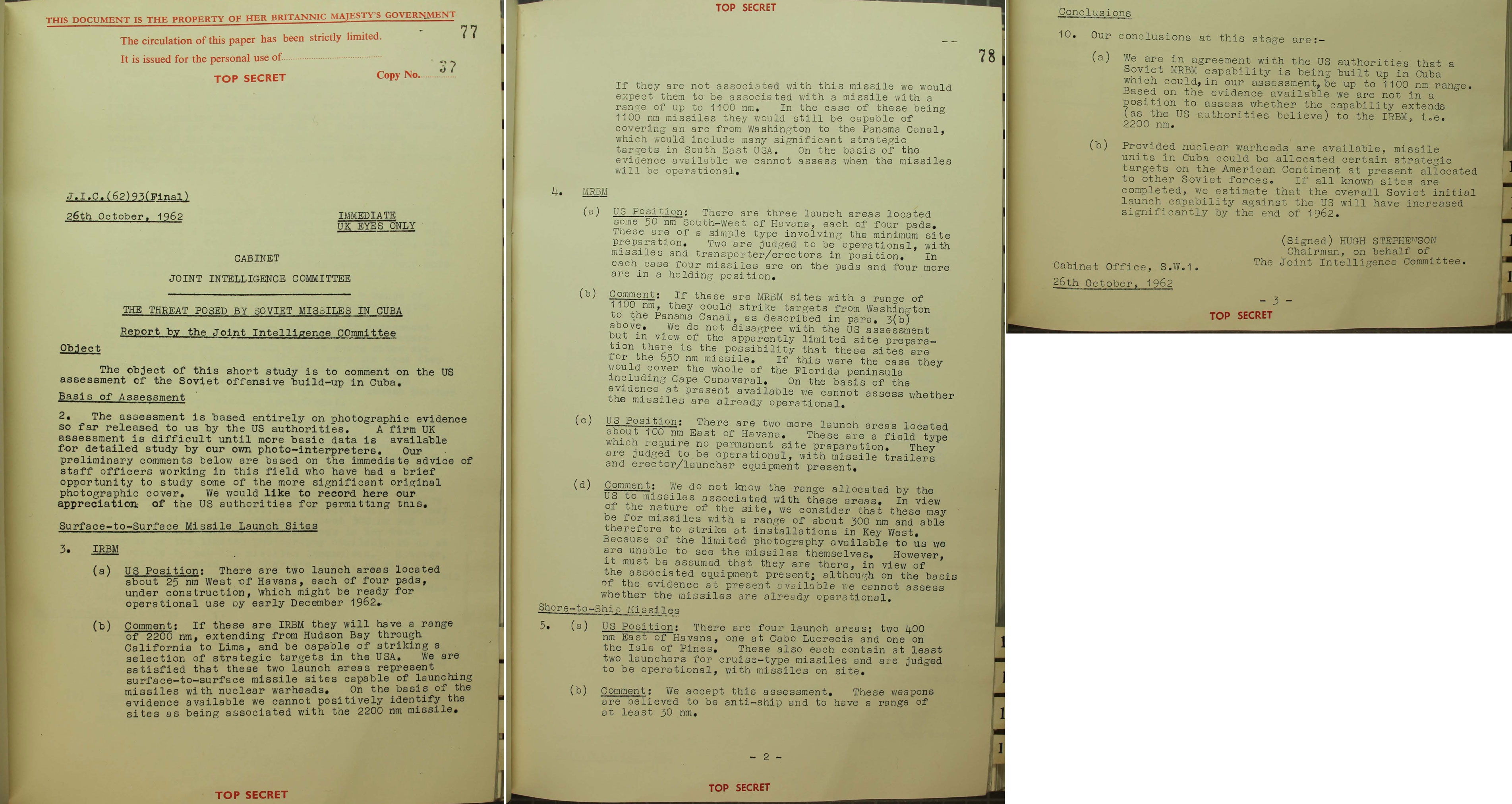
Report by the British Joint Intelligence Committee on Soviet missiles in Cuba, 26 October 1962. (Catalogue ref: CAB 129/111)
Transcript
IMMEDIATE
UK EYES ONLY
CABINET
JOINT INTELLIGENCE COMMITTEE
THE THREAT POSED BY SOVIET MISSILES IN CUBA
Report by the Joint Intelligence Committee
Basis of Assessment
- The assessment is based entirely on photographic evidence so far released to us by the US authorities. A firm UK assessment is difficult until more basic data is available for detailed study by our own phot-interpreters. Our preliminary comments below are based on the immediate advice of staff officers working in this field who have had a brief opportunity to study some of the more significant original photographic cover. We would like to record here our appreciation of the U.S. authorities for permitting this
Surface to Surface Missile Launch sites
3 IRBM [Intermediate range ballistic missiles]
- US Position: There are two launch areas located about 25nm West of Havana, each of four pads, under construction, which might be ready for operational use by early December 1962.
- Comment: If these are IRBM they will have a range of 2200 nm, extending from Hudson Bay through California to Lima, and be capable of striking a selection of targets in the USA. We are satisfied that these two launch areas represent surface to surface missile sites capable of launching missiles with nuclear warheads. On the basis of the evidence available we cannot positively identify the sites as being associated with the 2200 nm missile. the sites
If they are not associated with this missile we would expect them to be associated with a missile with a range of up to 1100nm. In the case of these being 1100nm missiles they would still be capable of covering an arc from Washington to the Panama Canal, which would include many significant targets in South East USA. On the basis of the evidence available we cannot assess when the missiles will be operational.
- MRB [Medium range ballistic missiles]
(a) US Position: There are three launch areas located some 50 nm South-West of Havana, each of four pads. These are of simple type involving the minimum site preparation. Two are judged to be operational, with missiles and transporter/erectors in position. In each case four missiles are on the pads and four more in a holding position.
(b) Comment: If these are MRBM sites with a range of 1100nm, they could strike targets from Washington to the Panama Canal, as described before in para 3(b) above. We do not disagree with the US assessment but in view of he apparently limited site preparation there is the possibility that these sites are for the 50 nm missile. If this were the case they would cover the whole of the Florida peninsula including Cape Canaveral. On the basis of the evidence at present available we cannot assess whether the missiles are already operational.
(c) US Position: There are two launch areas located 100 nm East of Havana. There are a field type which require no permanent site preparation. They are judged to be operational, with missile trailers and erector/launcher equipment present.
(d) Comment: We do not know the range allocated by the US missiles associated with these areas. In view of the nature of the site, we consider that these may be for missiles with a range of about 300 nm and able therefore to strike at installations in Key West. Because of the limited photography available to us we are unable to see the missiles themselves. However, it must be assumed that they are there, in view of the associated equipment present; although on the basis of the evidence at present available we cannot assess whether the missiles are already operational.
Shore-to-Ship Missiles
- (a) US Position: There are four launch areas: two 400 nm East of Havana, one at Cabo Lucrecia and one on the Isle of Pines. These also contain at least two launchers for cruise-type missiles and are judged to be operational, with missiles on site.
(b) Comment: We accept this assessment. These weapons are believed to be anti-ship and to have a range of at least 30nm.
…
Conclusions
- Our conclusions at this stage are:-
(a) We are in agreement with the US authorities that Soviet MRBM capability is being built up in Cuba which could, in our assessment, be up to 1100 nm range. Based on the evidence available we are not in a position to assess whether the capability extends (as the US authorities believe) to the IRBM, i.e.2200 nm.
(b) Provided nuclear warheads are available, missile units in Cuba could be allocated certain strategic targets on the American Continent at present allocated to other Soviet forces. If all known sites are completed, we estimate that the overall Soviet initial launch capability against the US will have increased significantly by the end of 1962.
(Signed) HUGH STEPHENSON
Chairman, on behalf of
The Joint Intelligence Committee
Cabinet Office, S.W.1
26th October, 1962
TOP SECRET
